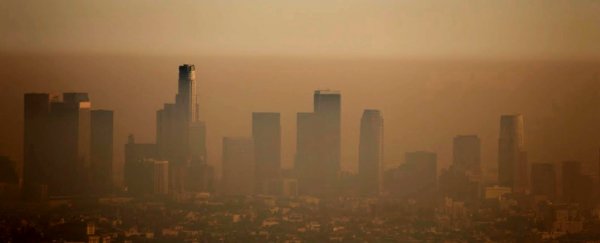On Monday, President Trump tweeted out a map, exclaiming that American air is the best air by far. That's not exactly true.
The map, grabbed from a World Health Organisation report out earlier this year, is an estimate of how much ultra-fine particulate matter (PM) people are breathing in around the world. This kind of particulate matter is only one component of air pollution.
“America: the Cleanest Air in the World - BY FAR!” pic.twitter.com/rMtxHSnof4
— Donald J. Trump (@realDonaldTrump) October 22, 2018
The map is tracking things like dust and other tiny particles floating around that are smaller than two and a half microns wide (what's sometimes referred to as "PM 2.5" pollution).
These super-fine particles are 30 times skinnier than a strand of human hair. Because they're so small, they can easily travel into the lungs – a serious problem for people who already have breathing and heart issues.
Heavy exposure over time can lead to reduced lung function and even death.
Common sources of these pollutants include emissions from cars and other vehicles, as well as heating oil, coal, secondhand smoke, chemicals wafting from power plants, smoke from cooking, and even natural sources like forest fires.
When the air is hazy, breathing it in can have dangerous, long-term effects on the brain.
Air pollution expert Gabriele Pfister, the deputy director at the National Center for Atmospheric Research (NCAR) Atmospheric Chemistry Observations and Modelling Lab, told Business Insider that using the map to point out how crystal-clean US air may be is misleading, at best.
"America doesn't have the cleanest air in the world just because it's white on this map," she said, adding that it's no surprise that we have fewer PM 2.5 pollutants than some developing countries where people still cook over open flames and burn down forests for fuel.
According to the US Environmental Protection Agency (EPA), aggregate emissions of six of the most common air pollutants have dropped 73 percent since 1970, when the agency got serious about cleaning up the air.
But the work isn't done. In 2014, the EPA estimated that between 50,000 and 120,000 people in the US die prematurely because of bad air.
The agency also notes on its website that "despite great progress in air quality improvement, approximately 111 million people nationwide lived in counties with pollution levels above the primary US National Ambient Air Quality Standards in 2017."
Check out this EPA map of counties that don't meet the Clean Air Act standards:
 (US EPA)
(US EPA)
"PM 2.5 is one component of air pollution," Pfister said. "If you look at ozone pollution, you will actually see that the US has quite a bit more ozone pollution than many regions in the developing world… that has to do with the ozone chemistry."
She worries about the air she breathes in Colorado, as more oil and gas operations open up near schools, hospitals, and people's homes.
"Specifically in the western US, we have leveled off. We are not clean," she said.
In terms of PM 2.5 pollution, the country with the world's cleanest air is New Zealand, while the US ranks seventh on the list. Meanwhile, the cleanest cities in the world (in terms of particulate concentrations) are in Sweden.
While breathing air in Stockholm is better for your health than inhaling in Shanghai, it's false to think that a single country could ever have the "cleanest" air, because we all live under the same sky, Pfister said.
If you're wondering how clean the air you're breathing right now is, check out the National Weather Service air quality forecast, or use the EPA's interactive air quality map.
This article was originally published by Business Insider.
More from Business Insider:
